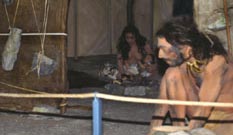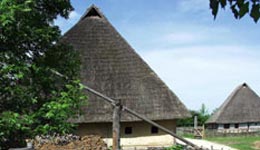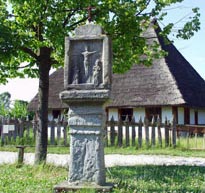|
|
 |
 |
 |
|
 Bad Windsheim Bad Windsheim
Open-air Museum II |
|
 The nearby museum of archaeology is presenting original finds and true to scale models to explain the development of settlement forms and construction techniques in Franconia in ancient history. The nearby museum of archaeology is presenting original finds and true to scale models to explain the development of settlement forms and construction techniques in Franconia in ancient history.
In a so-called ridge post house within the "Archaeological Village” a carpenter has installed his workshop. With his reconstructed lathe and a lot of other old tools the carpenter shows how goods and products of everyday necessities in former times were made.
|
|
 |
|
|
|
 |
|
The ridge post house shown in the open-air museum is a reconstruction based on archaeological finds from the 7th and 8th century. The sunk posts give stability to the whole construction. This ancient technique does not need any special wood screws for the bracing of the different parts of the building. The parts are connected only with rigging.
The name ridge post house is describing the construction technique used here: a row of wooden posts placed right in the middle of the house is supporting the roof ridge. Further posts that are sunk parallel to the posts in the middle are serving as wooden wall scaffolds, on which the special roof joists – the so-called "Rofen” – are resting finally.  |
|
|
|
|
|
|
|

|
|
|
|
Local history of Bad Windsheim |
|
During the 6th century Franconian colonization and settlement of the Windsheim area; the name Windsheim means "To the home of the Winid” ("Zu dem Heim des Winid”).
First prove by documents in 741 (Uuinidesheim).
First prove by documents as city 1284; later on free city.
During the Thirty Years’ War King Gustav Adolf of Sweden stays two times in Windsheim (1632).
On 3rd December 1730 the city centre is destroyed by a devastating fire.
1802 to 1803: End of the free city era.
1804 to 1809: Windsheim is under Prussian, French, Austrian and again French rule.
In 1810 Windsheim finally joins the Kingdom of Bavaria.
|
|







